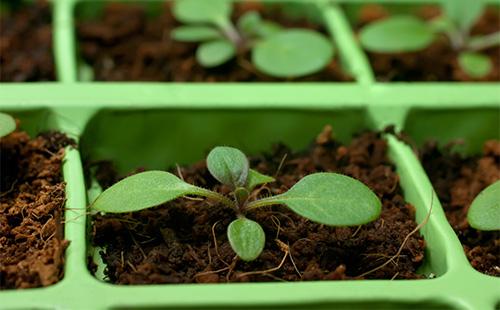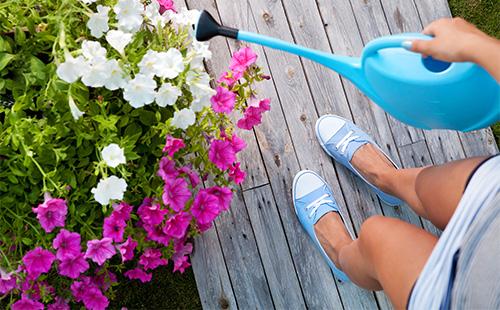The content of the article
A tropical plant native to South America conquers with beauty and abundant flowering. One of the varieties is found in the northern states. According to various sources, from 15 to 40 species are included in the genus of petunias.
Botanical Description
Petunia is a bushy plant with erect or creeping stems. The height of different species varies from 20 to 70 cm. The stems are highly branched. The pubescent sessile oval leaves are saturated green.
Funnel-shaped single flowers sit on short pedicels. Depending on the species, they bloom in the axils of the leaves or on the crown. In standard varieties, flowers are simple, in hybrid varieties, terry and fringed. The colors are different, some with interesting patterns, veins, a border of contrasting shades.
Popular types and varieties
Growing petunias at home begins with choosing the right variety. For apartments, miniature and ampelous views are more suitable. Each variety has several interesting hybrid varieties. Five main ones can be distinguished.
- Multi-flowered. The bushes are small, compact. The flowering is plentiful - the leaves are almost hidden under the buds. A simple, unpretentious culture, the best option for growing in a pot.
- Large flowered. It features beautiful colors up to 16 cm in diameter. The bush is quite large, it looks beautiful in a flowerpot mounted on a hill. This species is more common as a balcony plant. More than 100 hybrid varieties of large-flowered petunia are known.
- Ampelic. The stems are long, sprouting, highly branched. Differ in fast growth, plentiful and long flowering.
- Floribunda. An intermediate variety between multi-flowered and large-flowered petunia. Easy to care, hardy.
- Cascading. A common variety for home growing. From the long shoots a voluminous spherical bush is formed, densely covered with buds. With good care, hanging branches reach a meter long.
Seed breeding
Growing petunias from seeds is the easiest way to replenish your collection of indoor flowers. Adult plants are unpretentious, but you will have to tinker fairly well with seedlings. The process of growing seedlings consists of several stages.
Germination
Sowing of seeds begins around February. Sown them on the soil surface without embedding. Germination needs sunlight. Top seeds are sprayed with water from a spray bottle. Granular seeds are wetted more - the shell should get wet.
The container with crops is covered with glass or film, put in a bright, warm place. Maintain a stable temperature: 22–25 ˚С. Shoots appear after about a week. From this moment, they begin to air the greenhouse daily. The first time the film is removed for ten minutes. Gradually increase the airing duration. When the sprouts get stronger, the shelter is removed.
Small seedlings are very weak, prone to black leg disease. To obtain healthy seedlings, observe the irrigation regime, provide full lighting. If there is little natural light, install artificial lighting. Between watering, the earth is slightly dried, but does not allow its complete drying out.
Pick
After the formation of two or three true leaves, the first pick is carried out. Seedlings are planted in a more spacious box with loose soil. Between sprouts maintain a distance of 3-4 cm.
The second pick is carried out in a month. Seedlings are planted in separate pots, pinch the tip of the main root for the development of a complete root system. The first time after transplanting, the seedlings are kept in a slightly shaded place, carefully monitoring the soil moisture.
Topping
To form a lush, dense bush with an abundance of side shoots, the first pinching is performed early - after the appearance of the third or fourth pair of true leaves.
Removal of the growth point in young plants stimulates the active formation of lateral shoots. In this case, the flowering is slightly moved away. After pinching, the petunia is treated with growth stimulants.
Petunia care and creation of conditions for magnificent blossoming
When the seedlings get stronger, it becomes much easier to take care of them. Petunia is an unpretentious plant that requires a minimum of attention. How to care for a petunia so that its flowering continues until the fall? It is enough to create favorable conditions for her, adhering to several rules.
- Lighting. Petunia is a photophilous culture. During the period of active vegetation, it is placed on the western and eastern windows. On the south side they are always shaded. On the northern windows can only be kept with additional artificial lighting. Signs of a lack of light - the shoots are stretched out, thin out, the leaves turn pale.
- Temperature. He likes moderate heat of 20–25 ˚С. It easily withstands heat up to 30 ° C. At home, petunia does not bloom at temperatures below 19 ° C. In winter, a rest period at a temperature of 10–18 ˚С is desirable.
- Humidity. Petunia is neutral in air humidity, but gratefully responds to spraying. In winter, additional moisture is not needed - they are sprayed mainly in the summer.
- Watering. It is important to properly water the petunia, as it is susceptible to the development of rot and fungal diseases. It is undesirable to fill or dry the soil - you need to try to find a middle ground.
- Top dressing. Petunia begins to be fed two weeks after the last dive. With a frequency of ten days, potash fertilizers are applied. Sometimes you can feed organic, humic mixtures.

Propagation by cuttings
Ampel species, terry and mini-petunia can be propagated by cuttings. Rooting cuttings of petunias is simple.Ampel species can be propagated all year round, terry varieties - only in early spring.
For propagation of petunia cuttings take the tops of shoots with four to six leaves. The upper two are left, the lower ones are cleaned, the middle ones are cut off by half. Cuttings are planted in a loose, fertile substrate. After planting, the soil surface is sprinkled with a thin layer of sand.
The container with the cuttings is covered with a film, sprayed with a fungicide solution. The use of growth stimulants is usually not required - fresh cuttings take root easily. Until the roots appear, the container is kept in a well-lit, warm place, the soil is sprayed daily with warm, clean water.
In about two to three weeks it will be possible to plant the cuttings in small pots. As in the case of seedlings, young plants pinch over the fourth leaf to enhance branching.
Difficulties in sowing seedlings
An adult plant is unpretentious, but at the stage of growing seedlings, beginners often encounter problems. The most common situations, causes and solutions to the problem are shown in the table.
Table - Difficulties in growing petunia from seeds
| Problem | The reasons | Solutions |
|---|---|---|
| Seeds do not germinate well | - Sowing old seeds with expired germination; - deepening of crops; - use of pelleted seeds | - Petunia is sown superficially, kept in a well-lit place; - hard-coated seeds are watered harder or pre-soaked |
| Sprouts do not shed the seed coat | - Planting expired seeds; - improper storage of seeds; - maintaining a dry indoor climate | - The shell is sprayed, the container is covered with a film; - the soaked shell is removed with a needle |
| The stem is thinning at the warp and breaks off | - Defeat the black leg; - too wet soil - thickened crops | - The greenhouse is ventilated every day, the accumulated condensate is removed; - diseased seedlings are removed; - the soil is dried; - the remains of crops sprayed with a weak solution of fungicide |
| Seedlings turn yellow leaves | - Chlorosis; - waterlogging or drying out of the soil; - lack of nitrogen | - Spray seedlings with iron chelate; - regulate the irrigation mode; - make complex fertilizer with nitrogen content |
| Seedlings are drawn | - lack of light; - heat | - Put seedlings under fluorescent lamps; - pinch the tops; - add soil to the cotyledons |
| Seedlings Stop Growing | - Small volume of capacity; - lack of boron | - Planted in a larger container or individual pots; - sprayed with a weak solution of boric acid (0.6 g per liter of water) |
Common diseases
The main problem of petunia is fungal diseases. They develop as a result of systematic waterlogging of the soil, poor ventilation. Treatment is always carried out using fungicides. Information on the most common diseases is given in the table.
Table - Petunia Diseases
| Disease name | External manifestations | Treatment methods |
|---|---|---|
| Blackleg | - The root part of the stem blackens and softens; - the flower dies | - Sick plants destroy; - neighboring flowers are sprayed with any fungicide |
| Gray rot | - Brown spots and fluffy coating on the leaves appear | - Affected leaves crop: - Petunia is repeatedly sprayed with Fitosporin |
| Brown spotting | - Brown spots appear on the leaves | - The affected leaves are cut; - reduce air humidity; - sprayed with the drug "Fundazole" |
| Late blight | - Depressed brown spots appear on the stem; - leaves turn yellow, become covered with dark spots, dry | - Sick plants destroy |
| Powdery mildew | - A whitish coating appears; - leaves turn yellow, dry | - Cut off the affected parts of the plant; - petunia is treated with sulfur |
| Wet rot | - The root neck rot; - leaves wither and wrinkle; - the plant stops growing, dies | - Sick plants destroy; - the remaining ones are treated with Integral and Trichodermin drugs |

Typical pests
Quite often, gardeners have to deal with pests. They are especially active in low humidity. The most common pests, external signs of their appearance and methods of control are described in the table.
Table - Petunia Pests
| Pest name | External signs | Ways to fight |
|---|---|---|
| Aphid | - Found upon examination, yellow, sticky leaves; - the tops are twisted, deformed | - Perform trimming of all affected parts; - petunia washed with soapy water; - sprayed with weak infusion of tobacco dust |
| Whitefly | - White midges fly over a bush; - colonies of larvae are found on the underside of the leaves; - the plant stops growing, withers | - For the destruction of adult insects use aerosols "Raptor", "Dichlorvos"; - cut the leaves with colonies of larvae; - Petunia is sprayed with insecticides "Vermitek", "Inta-vir" |
| Thrips | - On the leaves showered pollen; - holes appear on the petals; - leaves are covered with silver coating | - Spray any insecticide several times, at five-day intervals. |
| Spider mites | - Light dots appear on the leaves; - the plant turns yellow, withers, becomes covered with cobwebs | - Increase air humidity; - regularly sprayed; - treated with the drug "Actara" |
Care for petunia consists of regular watering, providing good lighting, systematic dressing. Subject to the basic rules for growing petunias, it will quickly form a lush, abundantly flowering bush.

